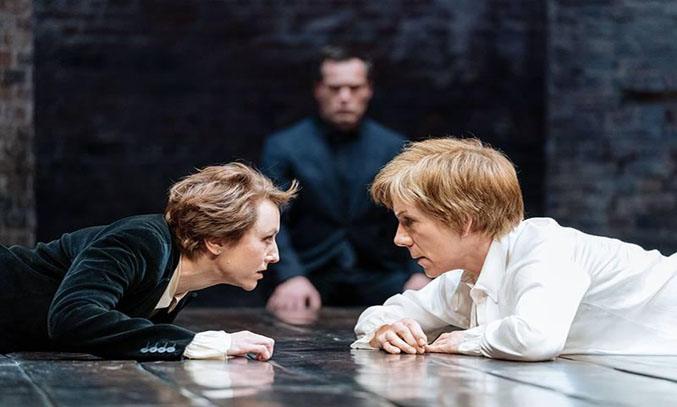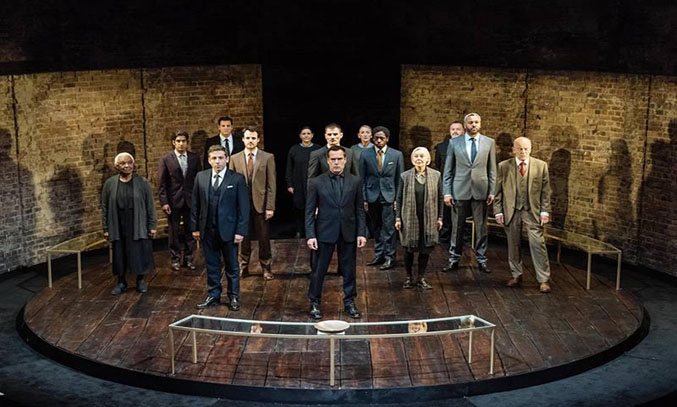
Lia Williams as Elizabeth and Juliet Stevenson as Mary Stuart in MARY STUART. Photo by Manuel Harlan.
Robert Icke’s riveting adaption of MARY STUART is an absorbing and timely piece of women in power and the pressures of a flawed political system
On the service, Robert Icke’s decision to allocate the leads for MARY STUART at the start of each performance by the toss of a coin may sound like a theatrical gimmick but it soon becomes clear that it’s actually rather clever. Icke’s riveting adaption of Friedrich Schiller’s 1800 play is anything but predictable and that very toss of a coin demonstrates how easily history might have shifted in the other direction. It’s also a brilliant and bold start to the deeply political piece which explores the final few days of Mary Stuart’s life.
MARY STUART centres on rival queens, Mary Stuart (also known as Mary, Queen of Scots) and Queen Elizabeth I. Following the murder of her husband, Mary flees Scotland and seeks refuge in England where she is promptly imprisoned by her cousin Queen Elizabeth I because of her claim to the English throne. Elizabeth desires to execute Mary but hesitates to sign her death sentence. The piece explores what happened when Elizabeth I is pushed to make a decision about the fate of her cousin, escalating towards an execution that is ultimately tragic for both victim and survivor.
The striking piece opens with Juliet Stevenson and Lia Williams facing each other on stage as a coin is placed in a brass bowl. Whoever gets heads (on this night it was Juliet Stevenson) gets to keep her head and as the coin spins (shown in close-up on TV screens in the auditorium), tensions begin to rise. Eventually settling, the adjudicator – the Earl of Leicester, played by John Light – indicates the outcome with the nod of a head. The other (Lia Williams) frowns slightly as she is stripped of her jacket and shoes and is bundled off to confinement as the imprisoned sister-queen.
At the click of fingers, everything speeds up and the action hurtles forward. While MARY STUART is based on historical events, the unpredictability of Icke’s production really makes you feel as though it could go either way. Here, Mary and Elizabeth are pitched as mirror images of each other as Hildegard Bechtler’s bare circular set rotates to mirror the dual perspectives and show the action from both sides. The decision to replicate the curved brick-walls of the Almeida (the West End venue where the play was first performed in 2016) is also effective in helping to instil the sense of imprisonment endured by both women.
In terms of performance, Stevenson as excels as Elizabeth, the strong, ferocious and violate queen who stalks the stage, making her court bow to the ground with just the click of her fingertips. As she navigates her way through assassination plots, duplicitous lovers and smooth-talking advisers, Elizabeth’s true fears and vulnerabilities are revealed, leaving behind a woman who is as trapped as her enemy, albeit in slightly different ways.
Williams is equally outstanding as Mary, her smaller frame and fluidity of movement making her a more sympathetic victim. Moving from desperation to eerie calmness, Williams’ Mary embraces her fate with complete exaltation and while it is Elizabeth who wins to reign another day, it is Mary who truly wins over the hearts of the audience.
There’s a strong ensemble supporting the two leads. John Light is deliciously hateful as Earl of Leicester, the lover who betrayed both queens, while Elliot Levey’s simpering Burleigh is a treat to watch. Rudi Dharmalingam is also strong as the quietly fanatical Mortimer.
In fact, the only real misstep is MARY STUART’s bloated length. While the story is compressed to 24 hours (the time flashing up on TV screens at the start of each act), at just over three hours long, the play is burdened by its length and could benefit from the odd trim here and there, particular in the first half which sees the audience starting to shift uncomfortably in their seats.
That said, this is a minor criticism and on the whole, Icke injects power and emotion into the riveting story we all know from the history books. The final scene, which sees the only extravagance in terms of staging, is also both arresting and moving, leaving behind an absorbing and timely piece of women in power and the pressures of a flawed political system.

MARY STUART runs at The Lowry until 21 April 2018.
Donna is the Founder and Editor of Frankly, My Dear UK. By day, she works as a digital marketing specialist, by night she reviews film, theatre and music for a wide range of publications including WhatsonStage and The Reviews Hub. Loves Formula 1, prosecco and life.










Social Profiles